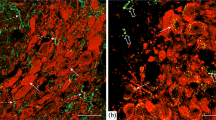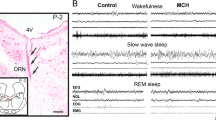Abstract
Placing the clawed toad Xenopus laevis on a black background stimulates the melanotrope cells in the pars intermedia of the pituitary gland to release proopiomelanocortin (POMC)-derived peptides, including α-MSH and N-acetylβ-endorphin. In this study three types of secretory granules, electron-dense(∼130 nm Ø), moderately electron-dense (∼ 160 nm Ø) and electronlucent (∼ 180 nm Ø), have been identified in these cells. Apparently, only dark granules are formed by the Golgi apparatus and lucent granules release their contents via exocytosis. Immuno-electron microscopy (immunogold double labelling) of glutaraldehyde-fixed and freeze-substituted material shows that desacetyl-α-MSH and N-acetyl-β-endorphin coexist in all three granule types. Quantification of immunostaining revealed that immunoreactivities to these peptides are lowest in the dark granules and highest in the light ones. It is proposed that intragranular processing of POMC to immunoreactive desacetyl-α-MSH and N-acetyl-β-endorphin involves an increase in granule size and a decrease in granule electron density. Black background-induced activation of the melanotrope cell is reflected by an increase in immunoreactivity of the secretory granules to each of the antisera. This suggests that cell activation stimulates the formation of peptides by intragranular processing of POMC and/or of intermediate POMC-processing products. In addition, cell activation evoked an increase in the percentage of the granule population that reacts with anti-N-acetyl-β-endorphin, probably by stimulating intragranular acetylation of β-endorphin. Apparently, this acetylation is a regulated event that occurs in the cytoplasm, independently from the acetylation of desacetyl-α-MSH which takes place near the plasmalemma at the time of granule exocytosis.
Similar content being viewed by others
References
Ayoubi TAY, Jenks BG, Roubos EW, Martens GJM (1992) Transcriptional and posttranscriptional regulation of the proopiomelanocortin gene in the pars intermedia of the pituitary gland of Xenopus laevis. Endocrinology 130:3560–3566
Båck N (1989) The effect of bromocryptine on the intermediate lobe of the rat pituitary: an electron-microscopic, morphometric study. Cell Tissue Res 255:405–410
Bliss CJ (1967) Statistics in Biology, vol 1. McGraw-Hill, New York
Buma P, Roubos EW (1985) Morphometric tannic acid and freezefracture studies of peptide release by exocytosis in the neuroen-docrine caudo-dorsal cells of Lymnaea stagnalis. J Electron Microsc (Tokyo) 34:92–100
Chang T-L, Gainer H, Russel JT, Loh YP (1982) Pro-opiomelanocortin converting enzyme activity in bovine neurosecretory granules. Endocrinology 11:1607–1614
Dores RM, Steveson TC, Lopez L (1991) Differential mechanisms for the N-acetylation of alpha-melanocyte-stimulating hormone and beta-endorphin in the intermediate pituitary of the frog, Xenopus laevis. Neuroendocrinology 53:54–62
Gainer H, Russel JT, Loh YP (1985) The enzymology and intracellular organization of peptide precursor processing; the secretory vesicle hypothesis. Neuroendocrinology 40:171–184
Hogben L, Slome D (1931) The pigmentary effector system: the dual character of endocrine coordination in amphibian colour change. Proc R Soc Lond [Biol] 108:10–53
Hopkins CR (1970) Studies on secretory activity in the pars intermedia of Xenopus laevis. 1. Fine structural changes related to the onset of secretory activity in vivo. Tissue Cell 2:59–70
Jenks BG, Verburg-van Kemenade BML, Martens GJM (1988) Proopiomelanocortin in the amphibian pars intermedia: a neuroendocrine model system. In: Hadley ME (ed) The melanotropic peptides, vol 1, Source synthesis, chemistry, circulation and metabolism. CRC Press, Boca Raton, Fla, USA, pp 103–126
Kawauchi H, Tsubokawa M, Kanezawa A, Kitagawa H (1980) Occurrence of two different endorphins in the salmon pituitary. Biochem Biophys Res Commun 92:1278–1288
Martens GJM, Jenks BG, Overbeeke AP van (1981) N-β-acetylation is linked to αMSH release from pars intermedia of the amphibian pituitary glands. Nature 294:558–560
Martens GJM, Weterings KAP, Zoest ID van, Jenks BG (1987) Physiologically induced changes in proopiomelanocortin mRNA levels in the pituitary gland of the amphibian Xenopus laevis. Biochem Biophys Res Commun 143:678–684
Maruthainar K, Loh YP, Smyth DG (1992) The processing of β-endorphin and α-melanotropin in the pars intermedia of Xenopus laevis is influenced by background adaptation. Endocrinology 135:469–478
Poisner AM, Trifaró JM (eds) (1982) The secretory granule. Elsevier, Amsterdam New York Oxford
Rijk EPCT de, Jenks BG, Wendelaar Bonga SE (1990) Morphology of the pars intermedia and the melanophore-stimulating cells in Xenopus laevis in relation to background adaptation. Gen Comp Endocrinol 79:74–82
Roubos EW (1984) Cytobiology of the ovulation-neurohormone producing caudo-dorsal cells of the snail Lymnaea stagnalis. Int Rev Cytol 89:295–346
Roubos EW, Ven AMH van de, Minnen J van (1987) Immunoelectron microscopy of formation, degradation and exocytosis of the ovulation neurohormone of Lymnaea stagnalis. Cell Tissue Res 250:441–448
Rouillé Y, Michel G, Chauvet MT, Chauvet J, Acher R (1989) Particular processing of pro-opiomelanocortin in Xenopus laevis intermediate pituitary. Fed Eur Biochem Soc 1:215–218
Schmidt ED, Roubos EW (1989) quantitative immunoelectron microscope and tannic acid study of neurohaemal and nonsynaptic peptide release by the caudodorsal cells of Lymnaea stagnalis. Brain Res 489:325–337
Shapiro HH, Wilk MB (1965) An analysis of variance test for normality. Biometrics 52:591–611
Slot JW, Geuze HJ, Gigengack S, Lienhard GE, James DE (1991) Immunolocalization of the insulin regulatable glucose transporter in brown adipose tissue of the rat. Cell Biol Toxicol 113:123–135
Steel RGD, Torrie JH (1960) Principles and Procedures of Statistics. McGraw-Hill, New York Toronto
Strien FJC van, Rijk EPCT de, Heymen PSH, Hafmans TGM, Roubos EW (1991) Demonstration of dopamine in electrondense vesicles in the pars intermedia of Xenopus laevis, by freeze substitution and postembedding immunogold electron microscopy. Histochemistry 96:551–556
Verburg BML, Jenks BG, Smits RJM (1987) N-terminal acetylation of melanophore-stimulating hormone in the pars intermedia of Xenopus laevis is a physiologically regulated event. Neuroendocrinology 46:289–296
Weatherhead B, Whur P (1972) Quantification of ultrastructural changes in the ‘melanocyte-stimulating hormone cell’ of the pars intermedia of the pituitary of Xenopus laevis, produced by change of background colour. J Endocrinol 53:303–310
Zoest ID van, Heijmen PS, Cruijsen PMJM, Jenks BG (1989) Dynamics of background adaptation in Xenopus laevis: role of catecholamines and melanophore-stimulating hormone. Gen Comp Endocrinol 76:19–28
Author information
Authors and Affiliations
Rights and permissions
About this article
Cite this article
Roubos, E.W., Berghs, C.A.F.M. Effects of background adaptation on α-MSH and β-endorphin in secretory granule types of melanotrope cells of Xenopus laevis . Cell Tissue Res 274, 587–596 (1993). https://doi.org/10.1007/BF00314557
Received:
Accepted:
Issue Date:
DOI: https://doi.org/10.1007/BF00314557




